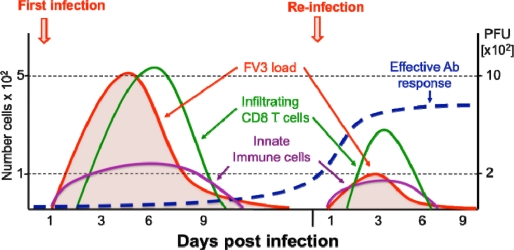Figure 2.
Schematic view of Xenopus adult immune response kinetics in infected kidneys. During both primary and secondary FV3 infections, MHC class II+ innate immune cell effectors (leukocytes) rapidly accumulate in the kidneys (violet line), the main site of infection, and pro-inflammatory genes (e.g., TNF-α, IL-1β) are induced. This is followed by an adaptive CD8 T cell response and infiltration (green line) that peak at 6 dpi during a primary infection. During a second FV3 infection, CD8 T cell response and infiltration peak 3 days earlier, which suggests T cell memory. However, the lower number of infiltrated CD8 T cells (5 time less) suggests that anti-FV3 antibodies (blue line) and B cell memory are playing a prominent role during secondary infection resulting in a faster viral clearance (red line).

